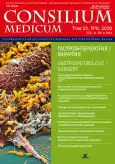Course of gallstone disease in persons with metabolic disorders
- Authors: Osadchuk M.A.1, Mironova E.D.1, Balashov D.V.2, Osadchuk M.M.2
-
Affiliations:
- Sechenov First Moscow State Medical University (Sechenov University)
- City Clinical Hospital №52
- Issue: Vol 21, No 8 (2019)
- Pages: 74-77
- Section: Articles
- URL: https://journals.rcsi.science/2075-1753/article/view/96825
- DOI: https://doi.org/10.26442/20751753.2019.8.190548
- ID: 96825
Cite item
Full Text
Abstract
Full Text
##article.viewOnOriginalSite##About the authors
Mikhail A. Osadchuk
Sechenov First Moscow State Medical University (Sechenov University)D. Sci. (Med.), Prof. Moscow, Russia
Ekaterina D. Mironova
Sechenov First Moscow State Medical University (Sechenov University)клин. врач-ординатор каф. поликлинической терапии лечебного фак-та Moscow, Russia
Dmitrii V. Balashov
City Clinical Hospital №52
Email: gp52@zdrav.mos.ru
Cand. Sci. (Med.) Moscow, Russia
Maksim M. Osadchuk
City Clinical Hospital №52Cand. Sci. (Med.) Moscow, Russia
References
- Peery A.F, Crockett S.D, Barritt A.S et al. Burden of Gastrointestinal, Liver, and Pancreatic Diseases in the United States. Gastroenterology 2015; 149 (7): 1731-41.e3
- Portincasa P, Moschetta A, Palasciano G. Cholesterol gallstone disease. Lancet 2006; 368 (9531): 230-9.
- Chowdhury M.Z.I, Anik A.M, Farhana Z et al. Prevalence of metabolic syndrome in Bangladesh: a systematic review and meta-analysis of the studies. BMC Public Health 2018; 18: 308.
- Lin I-C, Yang Y-W, Wu M-F et al. The association of metabolic syndrome and its factors with gallstone disease. BMC Fam Pract 2014; 15: 138.
- Zhu Q, Sun X, Ji X et al. The association between gallstones and metabolic syndrome in urban Han Chinese: a longitudinal cohort study. Sci Rep 2016; 22 (6): 29937.
- Shen H-C, Hu Y-C, Chen Y-F, Tung T-H. Prevalence and Associated Metabolic Factors of Gallstone Disease in the Elderly Agricultural and Fishing Population of Taiwan. Gastroenterol Res Pract 2014; 2014: 876918.
- Осадчук М.А., Киреева Н.В., Васильева И.Н., Миронова Е.Д. Влияние степени выраженности метаболических нарушений на диаметр конкрементов в желчном пузыре: клинико-инструментальные и лабораторные данные. Терапия. 2019; 5 (3): 55-9. @@Osadchuk M.A., Kireeva N.V., Vasilyeva I.N., Mironova E.D. Effect of severity of metabolic disorders on the diameter of stones in the gallbladder: clinical, instrumental and laboratory data. Terapiya. 2019; 3 (29): 55-9 (in Russian)
- Chen L-Y, Qiao Q-H, Zhang S-C et al. Metabolic syndrome and gallstone disease. World J Gastroenterol 2012; 18 (31): 4215-20.
- Shabanzadeh D.M, Skaaby T, Sørensen L.T et al. Metabolic biomarkers and gallstone disease - a population-based study. Scand J Gastroenterol 2017; 52 (11): 1270-7.
- Chang Y, Sung E, Ryu S et al. Insulin resistance is associated with gallstones even in non-obese, non-diabetic Korean men. J Korean Med Sci 2008; 23 (4): 644-50.
- Shaffer E.A. Epidemiology and risk factors for gallstone disease: has the paradigm changed in the 21st century? Curr Gastroenterol Rep 2005; 7 (2): 132-40.
- Osadchuk M.A, Mironova E.D, Vasileva I.N et al. Oral medical dissolution of gallstones in patients with gallstone disease. Pren Méd Argent 2019; 105 (1): 34-40.
- Ata N, Kucukazman M, Yavuz B et al. The metabolic syndrome is associated with complicated gallstone disease. Can J Gastroenterol 2011; 25 (5): 274-6.
- Ahmed M.J, Mahmood R, Rana R.S et al. Metabolic Syndrome: An Indicator of Complicated Gall Stone Disease? Cureus 2018; 10 (11): e3659
- Sakorafas G.H, Milingos D, Peros G. Asymptomatic cholelithiasis: is cholecystectomy really needed? A critical reappraisal 15 years after the introduction of laparoscopic cholecystectomy. Dig Dis Sci 2007; 52 (5): 1313-25.
- Schmidt M, Hausken T, Glambek I et al. A 24-year controlled follow-up of patients with silent gallstones showed no long-term risk of symptoms or adverse events leading to cholecystectomy. Scand J Gastroenterol 2011; 46 (7-8): 949-54.
- Shabanzadeh D.M, Sørensen L.T, Jørgensen T. Determinants for symptomatic gallstone disease readmissions - results from a cohort with screen-detected gallstone disease. J Visc Surg 2019; S1878-7886(19): 30025-6
- Everhart J.E, Khare M, Hill M, Maurer K.R. Prevalence and ethnic differences in gallbladder disease in the United States. Gastroenterology 1999; 117 (3): 632-9.
- Alberti K.G.M.M, Eckel R.H, Grundy S.M et al. Harmonizing the metabolic syndrome: a joint interim statement of the International Diabetes Federation Task Force on Epidemiology and Prevention; National Heart, Lung, and Blood Institute; American Heart Association; World Heart Federation; International Atherosclerosis Society; and International Association for the Study of Obesity. Circulation 2009; 120 (16): 1640-5.
- Amigo L, Zanlungo S, Mendoza H et al. Risk factors and pathogenesis of cholesterol gallstones: state of the art. Eur Rev Med Pharmacol Sci 1999; 3 (6): 241-6.
- Marques P, Collado A, Martinez-Hervás S et al. Systemic Inflammation in Metabolic Syndrome: Increased Platelet and Leukocyte Activation, and Key Role of CX3CL1/CX3CR1 and CCL2/CCR2 Axes in Arterial Platelet-Proinflammatory Monocyte Adhesion. J Clin Med 2019; 8 (5).
- Collado A, Marques P, Escudero P et al. Functional role of endothelial CXCL16/CXCR6-platelet-leucocyte axis in angiotensin II-associated metabolic disorders. Cardiovasc Res 2018; 114 (13): 1764-75.
- Mazidi M, Toth P.P, Banach M. C-reactive Protein Is Associated With Prevalence of the Metabolic Syndrome, Hypertension, and Diabetes Mellitus in US Adults. Angiology 2018; 69 (5): 438-42.
- Fairfield C.J, Wigmore S.J, Harrison E.M. Gallstone Disease and the Risk of Cardiovascular Disease. Sci Rep 2019; 9: 5830.
- Liew P-L, Wang W, Lee Y-C et al. Gallbladder disease among obese patients in Taiwan. Obes Surg 2007; 17 (3): 383-90.
- Fiorito G, Vlaanderen J, Polidoro S et al. Oxidative stress and inflammation mediate the effect of air pollution on cardio- and cerebrovascular disease: A prospective study in nonsmokers. Environ Mol Mutagen 2018; 59 (3): 234-46.
- Greenwood B, Tremblay L, Davison J.S. Sympathetic control of motility, fluid transport, and transmural potential difference in the rabbit ileum. Am J Physiol 1987; 253 (6 Pt 1): G726-729.
- Karhapää P, Malkki M, Laakso M. Isolated low HDL cholesterol. An insulin-resistant state. Diabetes 1994; 43 (3): 411-7.
- Smelt A.H.M. Triglycerides and gallstone formation. Clin Chim Acta 2010; 411 (21-22): 1625-31.
- Alipour A, van Oostrom AJHHM, Izraeljan A et al. Leukocyte activation by triglyceride-rich lipoproteins. Arterioscler Thromb Vasc Biol 2008; 28 (4): 792-7.
Supplementary files






